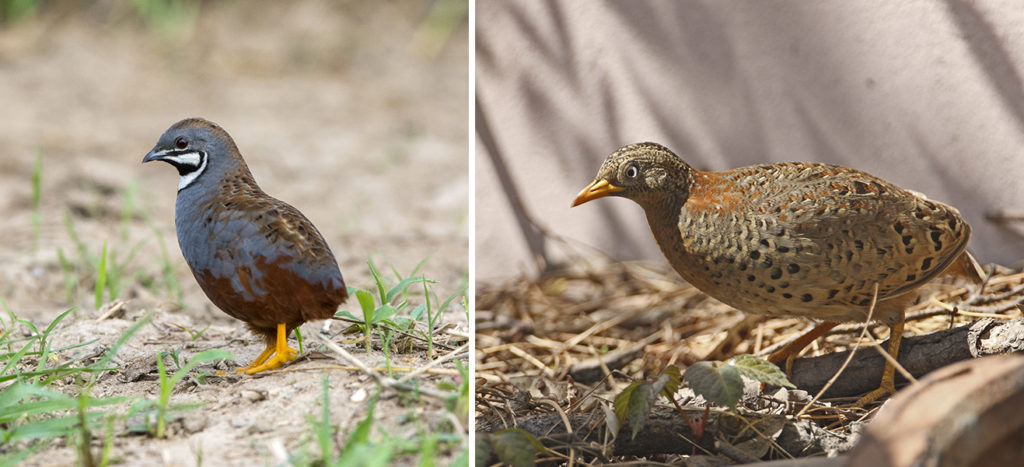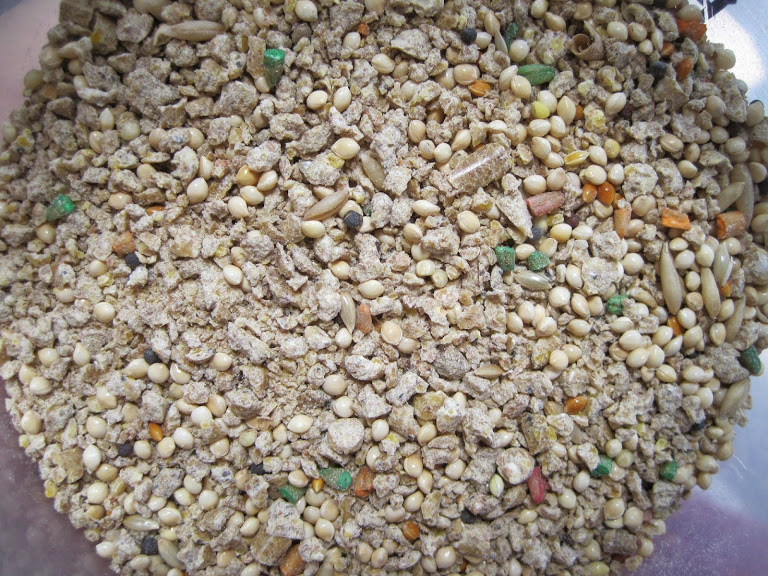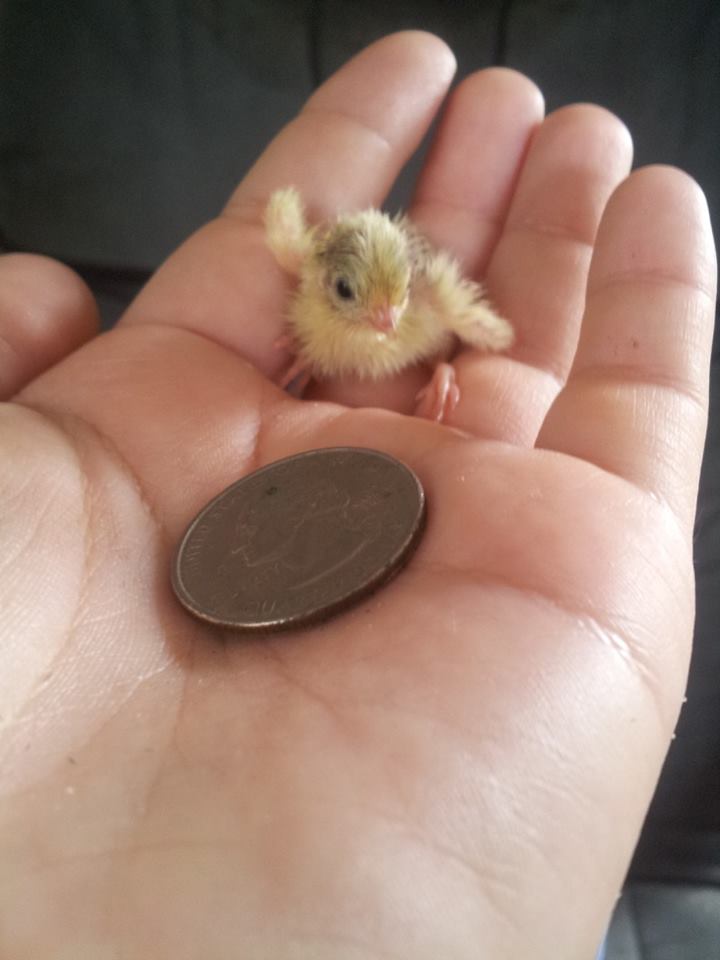Have you ever wanted to learn about or own Button Quail? Alexandra Douglas helps us understand these delightful birds in this Featured Article.

Chinese blue-breasted quail female and male
When I was 9 years old, I went to a parrot breeder’s home and saw these cute little birds on the bottom of the finch cages. They were eating the leftover seeds and making the sweetest sounds. I was told they were button quail. I wanted some as pets. In fact, I wanted a hundred of them and assumed I could just let them roam my bedroom. My parents were not too keen on that idea at all. Thirteen years later, I was able to raise button quail. I joined a button quail group on Yahoo Groups and got my first set of hatching eggs from Bracken Ridge Ranch in California. Sixteen days later, I hatched 14 little dime-sized quail on Halloween. Nothing is more exciting than starting out your homestead and hatching your own chicks, and I was getting started well with a wonderful mentor. I’d had years of experience with Coturnix quail prior, but after much research and information from my mentor, I’ve found that button quail are by far the most misunderstood little quail.
Buttonquail or Button Quail?
During the early 1900s, Western tourists visiting in China saw little caged birds hung in gardens and were told that they brought good fortune. Some brought the birds back to Europe and North America, and the story of good luck with them. “Button quail” as a nickname for the Chinese blue-breasted quail (Excalfactoria chinensis) may have developed during World War I. American soldiers probably saw them as pets in European homes and reported that they were “cute as a button,” comparing the size of the just-hatched birds to their uniform buttons. But the Chinese blue-breasted quail isn’t actually a “buttonquail.”
This is one of those moments when spelling matters. Buttonquail and button quail aren’t the same bird. They aren’t even the same genus, which makes reading about them potentially confusing. “Buttonquail” —one word—are considered the true buttonquail (genus Turnix, but not related to genus Coturnix). These birds are hemipodes (lacking a hind toe) and are related to plovers. “Button quail”—two words—come from the genus Excalfactoria and are the smallest of the quails.
The Chinese blue-breasted quail that I keep, and am writing about here, are button quail.

On the left is the Chinese blue-breasted quail (Excalfactoria chinensis), on the right is the Yellow-legged Buttonquail (Turnix tanki blandfordii).
Why Chinese Blue-Breasted Quail?
Depending on what you are looking for in a small bird, there are many species of quail from which to choose. Chinese blue-breasted quail (CBBQ) are best suited as pets or ground dwellers in aviaries. They don’t require much space, their care is quite straightforward, and frankly, they prefer to be left alone. They are quite beautiful, and you will enjoy observing their antics. CBBQ make cute little sounds, which, for the Star Wars fans, sound like a (non-aggressive) battle. The more you listen to them, the more you will hear a variety of noises as they communicate with each other.
Mated Pairs and Their Homes
I have tried colony raising and pairs with my quail over the years. In the wild, CBBQ are monogamous. This means that they pick one mate to breed with. Although colony raising requires fewer cages, it isn’t ideal for button quail as it increases flock stress, which can shorten their lifespans. In a colony setting, birds become more territorial and aggressive, even plucking out each other’s feathers. Most CBBQ breeders recommend paired housing, as it mirrors their wild behavior; the birds are calmer and live longer. The lifespan of a CBBQ is generally 4 to 5 years, although there have been cases of some living up to nine years.

Chinese blue-breasted quail pairs in their cages. Photo by author.
We use and recommend the high quality CBBQ pair cages made by Bracken Ridge Ranch in California. Quail live in the wire mesh cage. Below is a tray with a guard which can be pulled out for cleaning without the quail escaping. Guinea pig and hamster cages work as well. Cages shouldn’t be taller than 12 to 14 inches, as CBBQ do have short bursts of flight (often straight upward) and can injure themselves by banging into the cage roof. CBBQ have little feet, so you will want to fill the bottom tray up to the wire with wood shavings or soft bedding to protect their toes. Button quail are ground dwellers and do not need perches, but they will appreciate small spaces in which to hide and nest. Small hamster houses can be placed in the cage, along with grass clippings and leaves to create a more natural environment.
Seeds, Millet, and Worms as Treats
A Chinese blue-breasted quail in captivity will lay an egg a day with proper nutrition. Unlike other species of quail, the CBBQ do not need a lot of protein. A game bird starter of 30 percent protein, or breeder formula mixed with finch seeds, is ideal. Millet can be provided as well. Once a week, mealworms can be given as treats, however they are quite fatty and can cause production issues. Dry mealworms have more protein than fat and may work better than live worms. Live or dried crickets are also an ideal treat and mimic the CBBQ diet of insects and larvae in the wild.

Varied diet of seeds and grain. Photo by author.
Well-Bonded Pairs
A well-bonded pair of CBBQ have very interesting courting behaviors. The males will court their hens by offering pieces of food, such as mealworms, as well as twigs, grass, or other random objects. They will also puff out their feathers and strut about looking much larger than they really are.
Compared to other species of quail, the Chinese blue-breasted quail will brood their young, but not all couples make good parents. A clutch generally is 4 to 13 eggs. While some quail will want to sit on more, the larger clutches won’t all hatch. Keep in mind that the eggs are the size of a dime or a large jelly bean. If you want to ensure good hatch rates, using an incubator will be more effective than letting the couples brood. Incubation is a tad longer if a hen is sitting on the eggs. However, if you are raising CBBQ as pets, watching them brood their own clutch is an enjoyable experience. Generally, eggs will hatch out in 15 to 18 days.
Incubator Hatching
If you are going to hatch eggs using an incubator, keep track of which hens are laying. After 6 days, put all those eggs into an incubator with quail egg trays. As CBBQ eggs are quite small, don’t collect for more than 6 days, otherwise the eggs can dry out and hatch rates will go down rapidly. Turn the eggs for 13 to 14 days, keeping the humidity at 50 to 60 percent. In a still air incubator (one without a fan), make sure the temperature is no more than 100 degrees Fahrenheit. The small eggs can get too hot and kill the embryos if the temperature is higher. In a circulated incubator (one with a fan), the heat is more stable and consistent, therefore keeping the heat at 99.5 to 99.9 degrees is ideal. At day 13 or 14, you will “lock down” the incubator (keep it closed) to maintain humidity and warm temperatures. Incubation tends to be a trial and error sport. Every geographic location provides different temperatures and levels of humidity. Each incubation will be a test to see what works best for you. For example, when the quail pip, the humidity will rise on its own, but in drier climates, additional humidity may be required.
Brooding Tiny Babies
When hatched, Chinese blue-breasted quail really are as cute as a button. They are the size of a quarter and quite fragile.

Making sure that they have an adequate brooder is important, as a lot of accidents can happen in the chick stage. You might use a fish tank, or a box, together with a height-adjustable heat lamp for a large number of chicks. Use a towel or nonstick shelf liner on the base of the brooder so the birds can walk easily and develop leg strength. We do not recommend paper towels or shavings for the first two weeks. If the container doesn’t have a natural lid, add one after a week of brooding. Your CBBQ will be learning to jump in small spurts, and you won’t want to hunt for juveniles around your home.

Chinese blue-breasted quail chicks. Photo by author.
Varieties and Variants
In the wild, the CBBQ male has a blue-gray forehead, chest, and sides, with mottled brown feathers on the back of the head and wings. Captive birds have been bred to have many color variations which are difficult to classify. In 2002, breeders attempted to develop a common classification of plumage variants, but European and American breeders couldn’t agree on a set of standards. Blue- and red-breasted birds appear in the wild, as do silver, white, and cinnamon variations. But because pigment changes happen easily and rapidly, breeding captive birds true to their wild counterparts is difficult. This means that hatching eggs can only be sold as “a variety” of CBBQ. Keep this in mind if you want to sell hatching eggs.

A mutation or variant. Photo by author.
Tiny Chinese blue-breasted “button” quail are distinctive among domestic quail for both their size and their unique behaviors. They make great pets, and with proper nutrition, housing, and care, they are a delightful addition to a household. Perhaps they aren’t as popular as they were a century ago, but they do seem to be making a comeback. If you would like to add these charming birds to your home, I highly recommend investing in Jodi McDonald’s book A Closer Look at Button Quail. Jodi and this book are what made us so invested in these cute little quail.
Alexandra Douglas was born in Chicago, Illinois, and raised psittacines (parrots) at the early age of 9 years old. She moved to Oregon for college in 2005 and attended Oregon State University, majoring in Animal Sciences with an emphasis in Pre-Veterinarian Medicine and Poultry. She was fascinated with poultry as soon as she was handed a day old pharaoh Coturnix quail. She owns Stellar Game Birds, Poultry, Waterfowl, a poultry farm that sells chicks, hatching eggs, and is now working on selling its own line of quail cages. Alexandra has been featured in Aviculture Europe for her quail expertise. She has published a 410-page book on the Japanese quail called Coturnix Revolution.













3 Comments
Message*
Thank you for your great page on these precious little peeps! I am very interested in raising the Chinese Blues. Do you sell/ship eggs? We live in San Antonio, TX area.
I’d like to raise some button quails. I have 2 great incubators and a nice quail condo. Thank you, Robin
My advice, if you live in a subtropical climate such as the southeastern us or say the humid areas of California, go for it and just make good and sure which exact kind they are, bc the buttonquail in the turnix family may be what you think you are getting however I’ve got the ones that are the real McCoy thus didn’t have the correct supplies and most people who know all about quail will attempt to convince you that they’ve raised buttons themselves when maybe they don’t have a clue that the painted ones are a different quail (I honestly love these and just wish I’d known they were the Chinese Painted Quail, it’s day 6 and from the 8 eggs I started with 2 didn’t make it from the egg and the of the 6 that remained only 4 are still with me today. Some may say that’s an awesome turnout however the complications are from having the correct setup, food and other needs on hand as they are finicky little things.